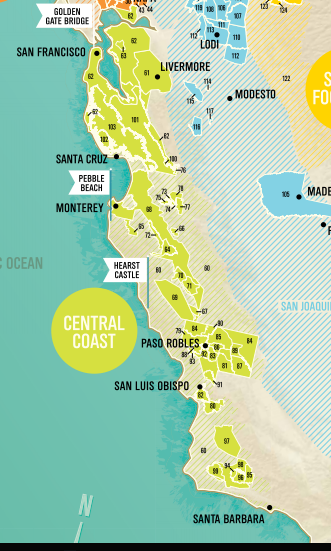I’ve been trying to gather up information for a few weeks now about just what is the Central Coast. But because it is divided into distinct subappelations, it is difficult to give it one identity. It’s easy to find information on Santa Barbara or Santa Cruz, but the Central Coast as a whole remains a mystery.
The Central Coast is one of the major AVAs, or American Viticultural Areas, of California, along with Napa and Sonoma. But unlike those places, it’s quite large–at least twice as long north-south as those, and extending as far inland as Napa at places. To think of it in simple terms, it is roughly the area between San Francisco and Santa Barbara, along the coast, with patches of vine-growing areas intermixed with houses, beaches, malls and farms.

The problem with trying to find a Central Coast identity is its size–it contains warm and cool areas, and a multitude of soils and terroirs. Culturally one might expect the areas to be different as well–it includes the fast-paced San Francisco as well as the laid-back Santa Barbara. Writer William Ausmus described it as “a hodgepodge of appellations and subappellations–” nothing sticking them together except general geography.
It is much easier to explore the identities of the smaller AVAs. In fact, Ausmus recommended dividing the area into thirds–north, mid and south, corresponding approximately to the areas of Monterey County, San Luis Obispo County, and Santa Barbara County–for this very reason. Indeed, each of these regions has different specialties. Paso Robles in SLO County is known for cabernet, for instance, whereas Monterey is known for pinot noir.
The Central Coast first made wine in the 1700s, when the missions along the coast needed wine for sacramental purposes. Native Americans used to work the vines for the Spanish settlers. In the 1800s, commercial wine started to be produced in both Sonoma and Los Angeles,∗ though the Central Coast didn’t begin taking off until the 1970s, lagging behind both Napa and Sonoma.∗∗
The major areas (that you’ll hear about) in the Central Coast are Livermore Valley, Monterey County, Paso Robles, San Benito County, San Francisco Bay, San Luis Obispo County, Santa Barbara County, Santa Clara County, and Santa Cruz Mountains. Most of those are official AVAs, but the counties of SLO, Santa Barbara, and Santa Clara are not–they only contain smaller AVAs (such as Happy Canyon in Santa Barbara).∗∗∗
Of these areas, the best known are Paso Robles (in SLO), Santa Barbara (which gained in recognition because of the movie “Sideways”), and perhaps Monterey.
The Central Coast has less cult wines than Napa and Sonoma. This means that it is easy to get very good to excellent wines from anywhere from $20 to $80–you don’t have to pay that $200 price tag or get on a waitlist to get on the mailing list. It’s also easy to visit for the same reason–no reservations needed for tastings at most places.
Although it contains a multitude of terroirs, I like to think you can taste something of the spirit of the Central Coast in the wine. If you close your eyes and let it wash over you, you may taste the psychedelic spirit of Haight Ashbury, the entrepreneurialism of Silicon Valley, or the mellowness of early morning surfers in Santa Barbara.
For the complete California Wine Map that identifies all the appellations and subappellations, click here.
Until next time, happy drinking!
-Carol
*Ausmus, William A. Wines & Wineries of California’s Central Coast, 2008, University of California Press.
∗∗”Central Coast.” Santa Barbara Vintners, 5/7/2014. http://www.sbcountywines.com/blog/Californias-central-coast.
∗∗∗”American Viticultural Areas of California.” California Wine Institute. http://www.wineinstitute.org/resources/avas
Waiting for next time! This region does sound like it has a lot to offer. Wine and beauty, a wonderful combination. I look forward to experiencing it through the grapes.
SER
LikeLiked by 1 person
Thanks for reading, Mom! I know it’s a great region, and we can have fun trying wine from it.
LikeLike
Reblogged this on The Diagonal Oenophile and commented:
Thought I’d share this on the Diagonal Oenophile…my latest post from my other blog.
LikeLike